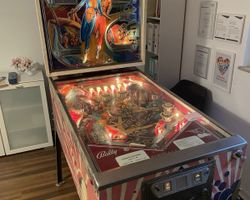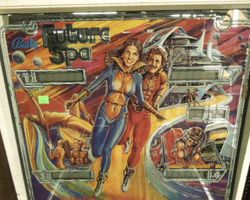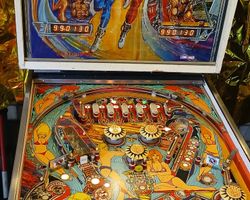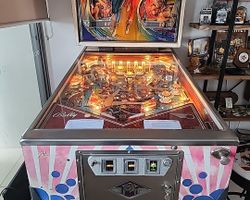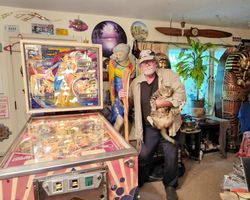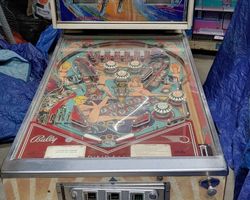Future Spa
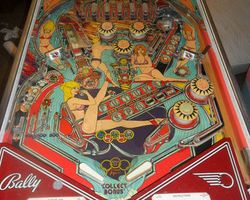
Average Prices: USD $300 to $1,500
Produced: December, 1979
Production Run: 6,400 units
Machine Type: Solid State Electronic
MPU: Bally MPU AS-2518-35
Players: 4
Design by: George Christian
Art by: Dave Christensen, Paul Faris
The late 1970s marked a transformative period in pinball, with solid-state electronics rapidly taking hold and designers pushing the boundaries of what a pinball machine could be. Emerging from this era was the Bally Manufacturing Corporation’s "Future Spa," a widebody pinball machine released in October 1979. This machine, model number 1173-E, saw a production run of 6,400 units, a notable quantity for its time. "Future Spa" embraced a distinctive theme, blending elements of fantasy, science fiction, and a utopian vision of fitness and relaxation, all wrapped in a playful, often campy, aesthetic that was indicative of the period.
The development of "Future Spa" involved several key figures within Bally. The overall design was helmed by George Christian, who contributed to the machine's structural and mechanical layout. The visual identity of the game was a collaborative effort, with Dave Christensen responsible for the playfield artwork. Christensen’s work on the playfield depicted bountiful, languid figures in a futuristic setting, contributing to the machine’s peculiar charm. Interestingly, the backglass artwork was completed by Paul Faris. With the production deadline approaching, Faris stepped in to paint the backglass while Christensen finalized the playfield. This division of labor resulted in a subtle artistic divergence between the playfield and backglass, which some enthusiasts appreciate for its unique character. The working title for the game, 'Bon Vivant,' can be seen in Christensen's pre-production drawings, offering a glimpse into the creative evolution of the project. On the technical side, Rehman Merchant was responsible for the software that brought the game’s mechanics to life on Bally's MPU AS-2518-35 system. "Future Spa" also held a significant technical milestone for Bally: it was the company's first machine to feature continuous background sound, a technological advancement that enhanced the player's immersive experience, a feature previously seen on Williams' 1978 "Flash." This continuous sound system had been tested on modified units of Bally’s 1979 "Voltan Escapes Cosmic Doom" before its full implementation in "Future Spa." Another notable aspect was the patent for the in-line drop targets, filed by Irwin J. Grabel and Glenn R. Andersen and assigned to Bally, a feature that would become central to the gameplay experience of "Future Spa."
Signature Features and Design
"Future Spa" is instantly recognizable due to its bold aesthetic and widebody form factor. The machine's artwork is a defining characteristic, presenting a "futuristic comic look" that captures the essence of late 1970s and early 1980s pop culture. Dave Christensen’s playfield art is rich with detailed, idyllic scenes of figures enjoying leisure in a stylized, futuristic environment. The backglass, by Paul Faris, is particularly noted for its "comical," "strange," and even "naughty" imagery, often becoming a focal point of discussion among collectors. While the playfield and backglass artwork are generally celebrated, the cabinet art receives mixed opinions, with some finding it less cohesive with the machine's overall theme.
As a widebody machine, "Future Spa" commanded a significant physical presence. This larger cabinet design allowed for a more expansive playfield, impacting the game's pacing. While some players perceive widebody games as inherently slower, leading to a "plodding" or "turgid" feel, others appreciate the deliberate, methodical play it encourages, characterizing it as "BIG." A distinct visual feature of "Future Spa" is its backglass logo. The "Future Spa" title illuminates with 12 individually blinking lamps behind a holographic plastic film, creating a "sparkle vision" or "3D sparkle" effect. This innovative lighting detail added a unique touch of visual flair, enhancing the futuristic ambiance. Furthermore, the implementation of continuous background sound was a pioneering move for Bally, providing an ever-present auditory layer that deepened the game's atmosphere beyond simple sound effects.
Playfield and Mechanics
The "Future Spa" playfield is a sprawling canvas, characteristic of its widebody design, offering a variety of shots and interactive elements. The lower playfield features the standard two flippers for primary ball control. Above these, players encounter five pop bumpers, strategically placed to create chaotic ball movement, particularly in the lower right area, which can occasionally lead to challenging drain situations. A single slingshot adds to the unpredictable bounce of the ball.
Central to the playfield’s design are the four in-line drop targets. These targets are arranged sequentially, and successfully hitting all four is crucial for gameplay progression and bonus accumulation. Players find hitting the final target in the series particularly satisfying, as it often unlocks significant rewards. Complementing these targets are two spinning targets, which, while sometimes difficult to hit consistently, offer high scoring opportunities when struck correctly. The playfield also includes a kick-out hole, or saucer, which captures the ball and ejects it back into play, often initiating modes or awards. A star rollover provides additional scoring opportunities and contributes to the overall bonus.
The left side of the playfield houses a left kicker lane, designed to divert the ball's path. A key feature here is the left outlane detour gate, which can be opened through specific gameplay achievements, offering a reprieve from what are otherwise described as "tough" or "mean" outlanes. The lower right outlane also features a small, challenging drain hole, often cited by players as a "heartbreaker" due to its propensity for unexpected ball losses. The expansive nature of the widebody playfield allows for long ball travel times, emphasizing the importance of precise flipper control and strategic shot placement. The overall aesthetic of the playfield, with Dave Christensen's vibrant artwork, contributes to player immersion, painting a picture of a leisure-focused future.
Gameplay Dynamics
The gameplay of "Future Spa" unfolds through a strategic combination of shots and objectives, culminating in a dynamic scoring system. Operating on a solid-state electronic (SS) platform with a digital display, the game encourages players to engage with its various features to maximize their scores. The core objective, and perhaps the most rewarding, involves spelling out "FUTURE SPA" by hitting specific targets. Successfully spelling these words is critical, as it directly impacts the bonus multiplier, which can then be applied to accumulated points. A distinguishing feature of "Future Spa," similar to some of its contemporaries, is that the bonus accumulated carries over to the next ball, encouraging continuous strategic play and building anticipation.
The in-line drop targets are integral to this bonus-building strategy, often serving as the skill shot at the game's start. Players must develop a consistent aim to clear these targets and advance their bonus multiplier. The dual spinners offer high point values when hit repeatedly, but their narrow targets can be challenging to access, demanding accuracy. Navigating the widebody playfield effectively is key; while the expansive space allows for long, sweeping shots, it also means the ball can sometimes travel for extended periods without engaging a feature, leading to a perceived "slow" pace if the machine isn't well-maintained. Conversely, a machine with a fresh wax and a steep playfield angle can play "super fast," challenging players with quick reactions.
The machine presents several inherent challenges that contribute to its "one more game" appeal. The left outlanes are known for their unforgiving nature, and the small drain hole in the lower right can abruptly end a promising ball. Players must learn to manage these "gotchas" and strategically utilize the left outlane gate when it’s opened. Success in "Future Spa" hinges on a balanced approach: focusing on the lucrative inline drop targets to build bonus, skillfully hitting the spinners for points, and mastering ball control to navigate the open playfield and mitigate drains.
Reception and Legacy
"Future Spa" generally garners a moderately positive reception within the pinball community, often described as a machine that "grows on you" due to its unique qualities and engaging gameplay. It holds a strong "one more game" appeal for many, making it a compelling addition to a collection, particularly for enthusiasts of late 1970s and early 1980s solid-state titles.
Among its strengths, the machine’s distinct artwork is frequently highlighted, especially the unique and often debated backglass. The rewarding nature of the inline drop targets is a consistent point of praise; players find them challenging to complete but highly satisfying. For some, the intelligent use of the widebody format is a strong point, allowing for varied shot opportunities and a grander scale of play. The machine's challenging yet fair "gotchas" and drain possibilities, along with a good variety of shots and objectives, contribute to its engaging experience. The "sparkle vision" effect on the backglass is also seen as a unique and inventive feature for its era.
However, "Future Spa" is not without its criticisms. The theme and artwork, while praised by many, can be polarizing for others, sometimes described as "quirky," "campy," or even "cheesy." The pacing of the game is a common point of contention; if not meticulously maintained, the wide playfield can indeed lead to a slow and "plodding" experience. The unforgiving nature of the outlanes and specific shots, like the difficult-to-hit spinners, can lead to frustration. Some players also note a disconnect or perceived lack of quality in the cabinet art compared to the playfield and backglass. Despite these criticisms, its quirks are often part of its charm.
"Future Spa" left a discernible mark on pinball history, primarily through its technical innovations for Bally. As the first Bally machine to incorporate continuous background sound, it set a precedent for future titles, enriching the auditory landscape of pinball. The widespread use of the patented in-line drop targets also showcased a commitment to innovative playfield mechanics. Its distinctive blend of a unique theme, widebody gameplay, and technical advancements solidify "Future Spa's" reputation as a memorable and significant solid-state pinball machine from a pivotal era in the industry.
Sponsored Links
 Ebay Listings
Ebay Listings
 Auction Results
Auction Results
| Cost | Location | Date |
|---|---|---|
| EUR €750 |  Hessen, Germany Hessen, Germany |
25 December, 2025 |
| EUR €2,250 |  Nordrhein-Westfalen, Germany Nordrhein-Westfalen, Germany |
10 June, 2025 |
| AUD $4,200 |  Queensland, Australia Queensland, Australia |
29 April, 2025 |
| USD $1,045 |  North Dakota, United States North Dakota, United States |
13 November, 2024 |
| USD $2,199 |  Pennsylvania, United States Pennsylvania, United States |
30 July, 2024 |
| USD $2,800 |  California, United States California, United States |
03 July, 2024 |
| USD $2,300 |  California, United States California, United States |
12 February, 2024 |
| USD $2,800 |  California, United States California, United States |
11 January, 2024 |
| USD $1,300 |  Georgia, United States Georgia, United States |
18 October, 2023 |
| USD $1,875 |  New York, United States New York, United States |
07 October, 2023 |


Private Policy · Search Website · Contact Us
As an eBay Partner, we may earn a commission from qualifying purchases made through links on this site, at no additional cost to you.
All trademarks and copyrighted materials remain property of their respective owners. All other content copyright 2007 - 2026 Pinpedia.

